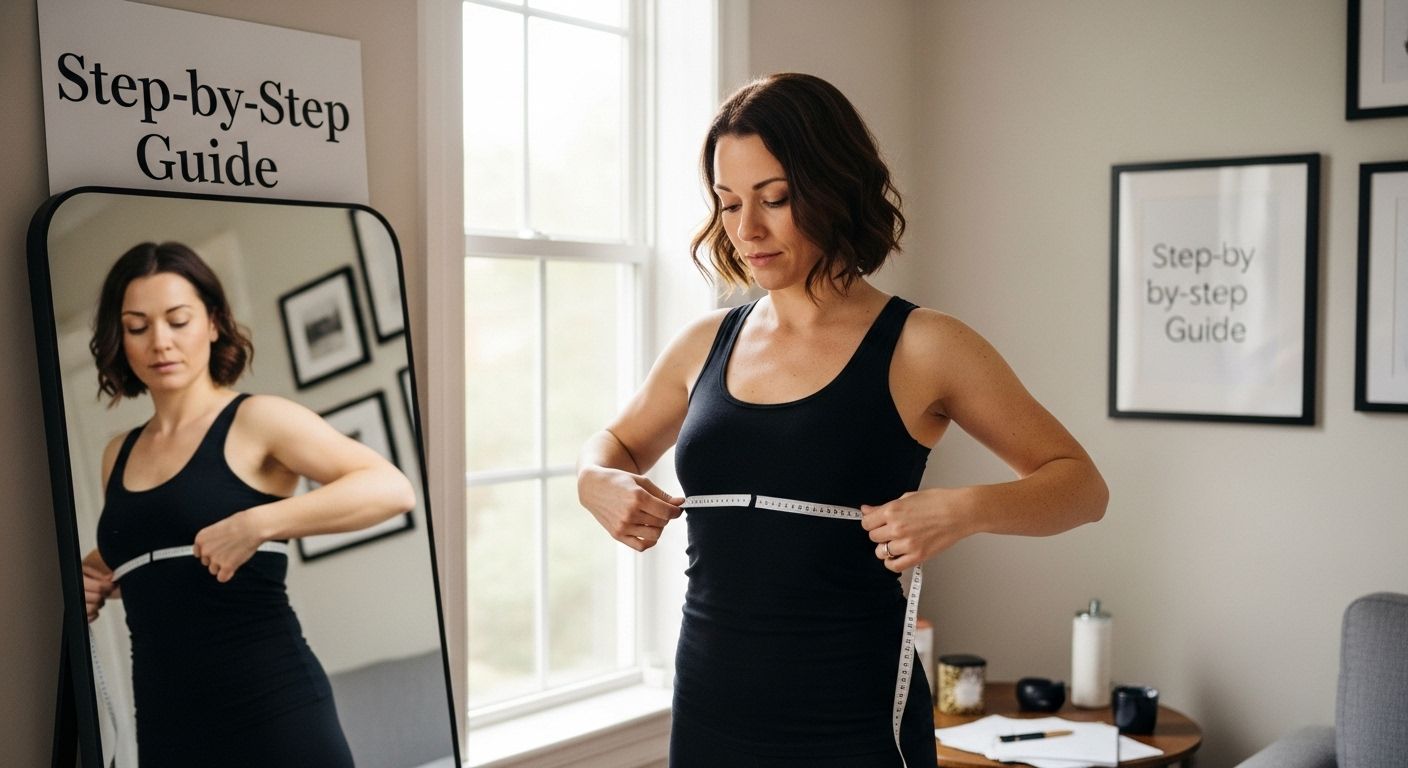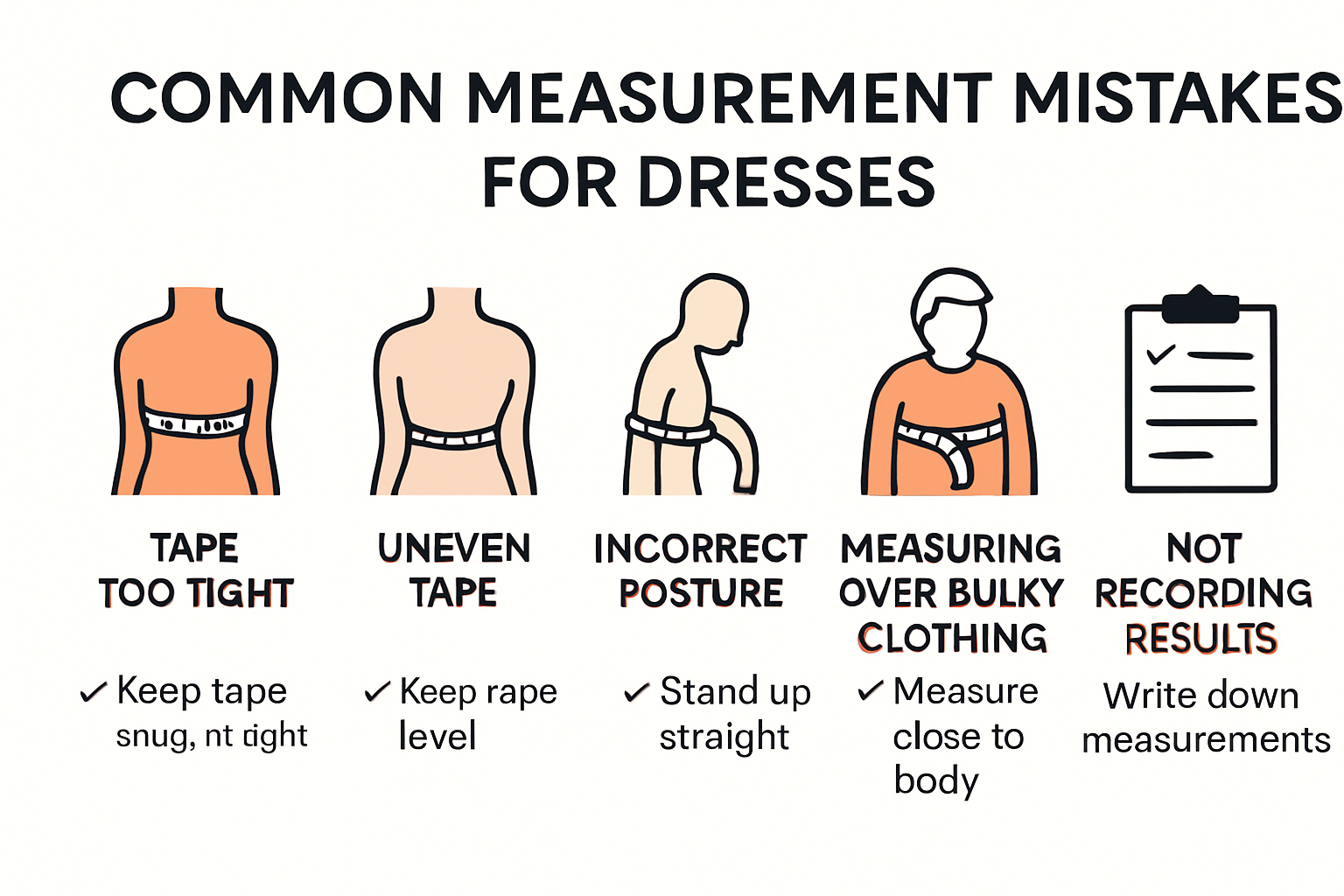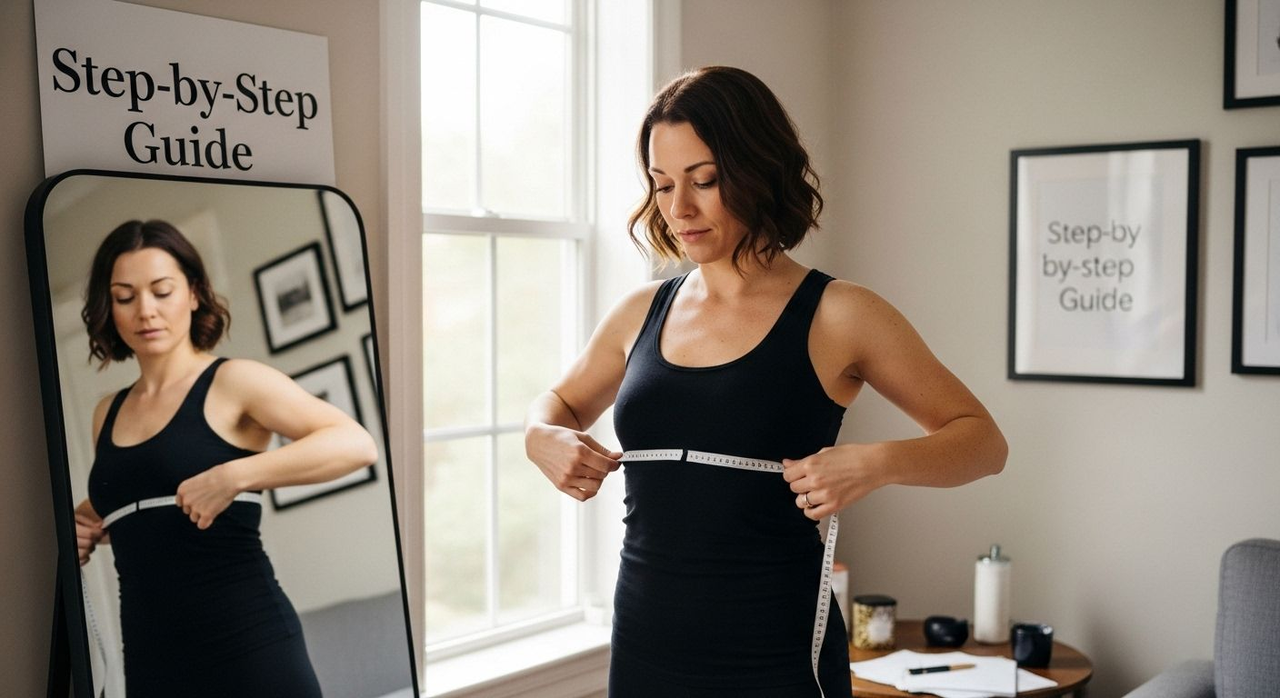How to Measure Yourself for Dresses: Step-by-Step Guide
How to Measure Yourself for Dresses: Step-by-Step Guide

Getting a dress that fits perfectly starts with your own measuring tape, not the clothing rack. Most people are surprised to learn that dress sizes can vary drastically between brands, and even a 1-inch measurement error can make the difference between a perfect fit and an unwearable outfit. So while clicking your favorite style might be tempting, your best bet for dress confidence comes down to spending just a few focused minutes with a tape measure in hand.
Table of Contents
- Essential Tools And Preparation Steps
- How To Take Accurate Dress Measurements
- Common Measurement Mistakes To Avoid
- Tips For Selecting The Right Dress Size Online
Quick Summary
| Takeaway | Explanation |
|---|---|
| Use a Flexible Measuring Tape | A flexible tape adheres to body curves, ensuring accurate measurements. Choose a durable fabric or fiberglass version for best results. |
| Measure at the Same Time Daily | Consistency in measuring conditions helps avoid inaccuracies. Aim for the same time and clothing choice every time for reliable results. |
| Double-Check Measurements | Always measure twice to ensure accuracy. Small discrepancies can lead to significant fitting issues if not corrected. |
| Understand Size Charts | Match your measurements with size charts and adjust for brand discrepancies to find the best fit. Sizes can vary significantly between brands. |
| Leverage Customer Reviews | Reading diverse customer feedback can reveal insights about fit and sizing, helping you make an informed decision when shopping online. |
Essential Tools and Preparation Steps
Accurately measuring yourself for dresses requires more than just a tape measure. Proper preparation and the right tools can make the difference between a dress that fits perfectly and one that misses the mark. Before you start your measuring process, gathering the essential tools and setting up the right environment will ensure you capture your body measurements with precision.
Gathering Your Measurement Tools
The foundation of accurate dress measurements begins with selecting the right tools. Gerber Technology recommends using a flexible measuring tape as your primary tool. Unlike rigid rulers, a flexible measuring tape conforms to your body’s curves, providing the most accurate readings. Opt for a tape measure that is at least 60 inches long and made of durable fabric or fiberglass material.
In addition to the measuring tape, you will need a few supporting items:
To help you prepare for taking your measurements, here’s a checklist of essential tools you should gather before starting the process:
| Tool | Purpose | Ready? |
|---|---|---|
| Flexible Measuring Tape | Main tool for accurate body measurements | |
| Notepad and Pen | To record your measurements immediately | |
| Full-length Mirror | Allows you to check tape placement and posture | |
| Fitted Clothing | Ensures measurements reflect your true body size |
Check off each tool to make sure you’re fully prepared for accurate measurement.
- Notepad and Pen: To record each measurement precisely
- Full-length Mirror: For checking your posture and measurement placement
- Fitted Clothing: Wear tight-fitting undergarments or a bodysuit to get the most accurate measurements
Preparing Your Body and Space
Sew Guide emphasizes the importance of proper body positioning when taking measurements. Stand in a relaxed but upright position, keeping your feet together and maintaining a natural stance. Avoid sucking in your stomach or puffing out your chest, as this can distort your true measurements. If possible, have someone assist you to ensure the measuring tape remains straight and level.
Temperature and clothing can significantly impact your measurements. Choose a time when you are not bloated or experiencing water retention. Remove any bulky clothing that might add extra inches to your frame. For the most consistent results, measure yourself at the same time of day and wear the same type of undergarments you plan to wear with the dress.
Measurement Technique and Precision
When wrapping the measuring tape around your body, ensure it remains parallel to the ground and sits flat against your skin without pulling too tight or hanging loose. The tape should be snug but not compressed. For bust, waist, and hip measurements, measure at the fullest or narrowest points respectively. Keep the tape measure comfortably close to your body without indenting the skin.
Double-check each measurement by measuring twice and comparing the results. Small discrepancies can occur, so taking multiple measurements helps ensure accuracy. If you find a significant difference between measurements, repeat the process to confirm your initial readings.
By investing time in proper preparation and using the right tools, you set yourself up for success in finding a dress that fits beautifully and makes you feel confident. Remember, precise measurements are your key to dress shopping success.
How to Take Accurate Dress Measurements
Taking accurate dress measurements requires precision and a systematic approach. Understanding how to measure different body parts correctly will help you select the perfect dress that fits like a glove. Sewing & Craft Alliance emphasizes that consistent and careful measurement techniques are crucial for achieving the best fit.
Bust and Chest Measurements
The bust measurement is one of the most critical measurements for dress fitting. Ohio State University Extension recommends measuring around the fullest part of your bust while wearing a well-fitting bra. Stand with your arms relaxed at your sides and keep the measuring tape parallel to the ground. Ensure the tape is snug but not tight, allowing for a natural body contour.
To get an accurate bust measurement:
- Wear a supportive bra: Use the same type of bra you plan to wear with the dress
- Stand naturally: Keep your posture relaxed but straight
- Measure horizontally: Wrap the tape around the fullest part of your bust, typically at nipple level
Waist and Hip Measurements
Waist and hip measurements are equally important for dress selection. For the waist, measure at the narrowest point of your torso, typically just above your belly button. When measuring hips, wrap the tape around the fullest part of your hips and buttocks. Keep the tape measure level and snug against your body without compressing the skin.
Pro tips for waist and hip measurements:
- Find your natural waistline: This is typically the smallest part of your torso
- Measure hip width: Ensure the tape is horizontal and passes over the fullest part of your hips
- Breathe normally: Avoid sucking in your stomach or holding your breath
Additional Body Measurements
Beyond bust, waist, and hip measurements, consider additional measurements that can impact dress fit. Measure your shoulder width from one shoulder point to the other, and your dress length from the shoulder to where you want the hem to fall. Shoulder measurements are crucial for ensuring the dress drapes correctly, while length measurements help you choose the right dress style.
Consider these additional measurements:
- Shoulder width: Measure from the tip of one shoulder to the other
- Dress length: Determine where you want the dress to fall
- Arm length: Measure from the shoulder to the wrist for sleeve considerations
Remember that practice makes perfect. Take your time, double-check measurements, and consider having a friend assist you for the most accurate results.
Each measurement contributes to finding a dress that not only fits well but makes you feel confident and comfortable.

Common Measurement Mistakes to Avoid
Measuring yourself for a dress might seem straightforward, but several common mistakes can lead to ill-fitting garments and unnecessary frustration. Wikisource Dressmaking Guide highlights that precision is key to achieving a perfect dress fit.
Incorrect Tape Placement and Tension
One of the most frequent errors in dress measurements is improper tape placement and tension. Research on Garment Fitting reveals that measuring tape should be parallel to the ground and maintain consistent tension. Too loose, and you will add unnecessary inches to your measurements. Too tight, and you will compress your body, creating an inaccurate representation of your true size.
Common tape placement mistakes include:
- Uneven Tape: Allowing the measuring tape to slope or twist
- Inconsistent Pressure: Pulling the tape too tight or leaving it too slack
- Incorrect Angle: Not keeping the tape horizontal or vertical as required
Measurement Environment and Clothing Errors
USDA Garment Research emphasizes that your measurement environment and clothing significantly impact accuracy. Taking measurements while wearing bulky clothing can add inches to your true body size. Similarly, measuring at different times of day or under varying physical conditions can produce inconsistent results.
Key environmental and clothing mistakes to avoid:
- Wrong Undergarments: Not wearing the same type of bra or shapewear you will use with the dress
- Time of Day Variations: Measuring when bloated or after eating a large meal
- Posture Inconsistencies: Not maintaining a consistent, natural stance
Self-Measurement Technique Pitfalls
Self-measurement requires extra attention to detail. Many people struggle with reaching around their body or maintaining a straight tape line. Attempting to measure yourself without assistance can lead to bent tape, incorrect angles, and skewed measurements. While it is possible to measure yourself, having a friend or using a mirror can significantly improve accuracy.
Technique mistakes that compromise measurement precision:
To minimize fitting errors, it’s important to be aware of the most common measurement mistakes people make. The table below summarizes these key mistakes and their impact on measurement accuracy:
| Common Mistake | Description | Resulting Issue |
|---|---|---|
| Uneven Tape | Measuring tape is sloped or twisted | Inaccurate body width |
| Inconsistent Pressure | Tape pulled too tight or left too loose | Over- or underestimating size |
| Incorrect Angle | Tape not held level horizontally or vertically | Skewed measurement |
| Wrong Undergarments | Wearing different or bulky undergarments during measurement | Added or lost inches |
| Time of Day Variations | Measuring when bloated or in varying physical states | Inconsistent measurements |
| Posture Inconsistencies | Not standing naturally or consistently | Altered body dimensions |
| Twisting to Measure | Contorting body to reach measurement points when alone | Skewed tape position |
| Forgetting to Write Down | Not recording results immediately after each measurement | Loss or confusion of values |
Use this table as a quick reference to ensure you avoid these common pitfalls.
- Twisting to Measure: Contorting your body to reach around yourself
- Guessing Measurement Points: Not identifying exact measurement locations
- Forgetting to Write Down: Not recording measurements immediately
To minimize these mistakes, take your time and be methodical. Consider recording a video of your measurement process or asking someone to help you. Remember that each small inaccuracy can compound into a significant fitting issue. By being aware of these common pitfalls, you can ensure your dress measurements are as precise as possible, leading to a garment that fits beautifully and makes you feel confident.

Tips for Selecting the Right Dress Size Online
Selecting the perfect dress size online can feel like navigating a complex maze, especially when you cannot physically try on the garment. New Mexico State University’s Fashion Guide highlights that understanding visual perception and sizing strategies can significantly improve your online shopping experience.
Understanding Size Charts and Measurements
Size charts are your most reliable tool when shopping online. Unlike in-store experiences, you will not have the luxury of immediate fitting. Virtual Try-On Research suggests carefully comparing your precise measurements with the brand’s specific size chart. Do not assume that your standard size will be consistent across all designers or brands.
Key strategies for using size charts effectively:
- Compare Measurements: Match your exact measurements to the chart
- Check Multiple Points: Look beyond just bust or waist measurements
- Consider Brand Variations: Different brands have different sizing standards
Visual and Fabric Considerations
Fashion Color and Texture Research reveals that visual elements can dramatically impact how a dress fits and looks. Colors and textures play crucial roles in creating optical illusions that affect perceived body size. Cool colors like blues and greens can create a slimming effect, while warm colors such as reds might make you appear larger.
Important visual and fabric considerations:
- Color Selection: Choose colors that complement your body shape
- Fabric Weight: Consider how different materials drape on your body
- Texture Impact: Understand how soft or structured fabrics affect fit
Leveraging Customer Reviews and Feedback
Customer Review Size Recommendation Study demonstrates the immense value of reading customer reviews when selecting online dress sizes. These reviews often provide real-world insights into how a particular dress fits, stretches, or runs in size. Pay special attention to comments about fit, fabric quality, and potential sizing discrepancies.
Strategies for using customer reviews effectively:
- Read Multiple Reviews: Do not rely on just one or two opinions
- Look for Detailed Feedback: Seek reviews that discuss specific fit details
- Check Reviewer Body Type: Compare reviews from people with similar body measurements
Remember that online dress shopping requires patience and careful research. By combining precise measurements, understanding visual aesthetics, and leveraging customer experiences, you increase your chances of finding a dress that fits beautifully and makes you feel confident. When in doubt, many online retailers offer flexible return policies that allow you to exchange or return items that do not meet your expectations.
Frequently Asked Questions
How do I take accurate measurements for my bust?
To measure your bust accurately, wear a well-fitting bra and stand with your arms relaxed at your sides. Wrap a flexible measuring tape around the fullest part of your bust, keeping the tape horizontal and snug but not tight.
What should I wear when measuring myself for a dress?
Wear fitted clothing or tight-fitting undergarments while measuring. This will help ensure that the measurements reflect your true body size without any added bulk from loose clothing.
How can I ensure my measurements are precise?
Measure yourself at the same time of day, in the same type of clothing, and avoid any extreme physical changes like bloating. Always double-check your measurements by measuring twice and making sure the tape is level and secure, but not compressed.
What common mistakes should I avoid while measuring myself?
Avoid common mistakes such as using an uneven tape, measuring while wearing bulky clothing, or measuring at different times of the day. Also, ensure that the placement of the measuring tape is correct and that you’re recording measurements immediately.
Ready for a Flawless Dress Fit?
Tired of the guesswork and disappointment that comes from online dress shopping? You just learned how a single misstep with the measuring tape can quickly ruin your plans for that perfect special occasion look. Our guide highlighted the pain of inconsistent sizing, the stress of guessing between charts, and the frustration when your dream dress does not fit like you imagined.
When you measure yourself with care, you deserve a dress that honors every inch. At Dress Me Up NY, we turn your precise measurements into a celebration of style. Our collections are not just about trendsetting designs—they are about giving you confidence, comfort, and elegance for every event. From statement new arrivals to timeless formal dresses, find the styles that match both your measurements and your dreams.

Do not let your hard work go to waste. Shop now at Dress Me Up NY and let your perfect measurements lead you to a flawless fit, exclusive offers, and a shopping experience built for your real needs. The special occasion you have been looking forward to is closer than ever. Take the next step today and discover your new favorite dress.
Recommended
- Terani Couture 251P4397 Scoop Neck Strapless Long Dress
- Contact Us - Dressmeup Newyork
- Tarik Ediz 98402 Tafetta Halter Neck Sleeveless Long Dress
- Terani Couture 251P4002 Embroidered Tulle Strapless Dress

